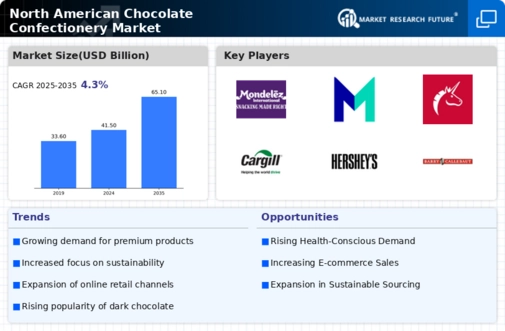Top Industry Leaders in the North American Chocolate Confectionery Market

The North American chocolate confectionery market is a dynamic and competitive landscape, characterized by the presence of several key players vying for market dominance. The industry is influenced by consumer preferences, innovation, and marketing strategies that shape the competitive scenario.
Strategies Adopted
Mondelez International, with brands like Cadbury and Toblerone, strategically positions itself through a global perspective, leveraging its international presence to gain a stronghold in the North American market. Ferrero, known for Nutella and Ferrero Rocher, emphasizes premium quality and strategic acquisitions, like its purchase of Nestle's U.S. confectionery business, to expand its market presence. Lindt & Sprüngli, a Swiss chocolatier, focuses on premium and artisanal offerings, targeting a niche market segment.
Market Share Analysis
Market share analysis in the North American chocolate confectionery sector is influenced by factors such as brand recognition, distribution channels, product quality, and consumer loyalty. Companies invest significantly in marketing and advertising to enhance brand visibility and connect with consumers. The ability to adapt to changing consumer preferences and introduce innovative products also plays a crucial role in determining market share.
Emerging Companies
In recent years, there has been a surge in the entry of new and emerging companies in the North American chocolate confectionery market. These companies often bring unique flavors, ethical sourcing practices, and innovative packaging to differentiate themselves. Start-ups like Tony's Chocolonely, known for its commitment to fair trade and eliminating child labor in the cocoa supply chain, have gained traction, appealing to socially conscious consumers.
Industry news in the North American chocolate confectionery market highlights the growing importance of sustainability and ethical sourcing. Consumers are increasingly demanding transparency in the supply chain, prompting companies to invest in sustainable and responsible practices. This trend is reshaping the competitive landscape, with companies that prioritize environmental and social responsibility gaining a competitive advantage.
Current company investment trends in the North American chocolate confectionery market reveal a focus on digital marketing, e-commerce, and technology-driven solutions. With the rise of online shopping and changing consumer behavior, companies are investing in e-commerce platforms and digital marketing strategies to engage with consumers directly. Additionally, investments in technology, such as automation and data analytics, are being made to streamline operations and gain insights into consumer preferences.
Competitive Scenario
The overall competitive scenario in the North American chocolate confectionery market is characterized by intense rivalry, innovation, and a constant pursuit of market leadership. Companies are adapting to the evolving landscape by diversifying their product portfolios, embracing sustainability, and leveraging digital technologies. The future of the market will likely be shaped by continued consumer demand for premium and ethically sourced products, prompting companies to stay agile and responsive to emerging trends in order to maintain a competitive edge.
The company's diverse portfolio, including iconic brands like M&M's and Snickers, has contributed to its market share. Hershey, another industry heavyweight, has employed a strategy of brand diversification through acquisitions, such as its purchase of Amplify Snack Brands, to broaden its product offerings.
Key players:
- Mondelez (US)
- Mars (US)
- Blommer (US)
- Puratos (Belgium)
- Foley’s Candies LP (Canada)
- Cargill (US)
- Nestle SA (Switzerland)
- Hershey (US)
- Barry Callebaut (Switzerland)
- Guittard Chocolate Company (US)
- Valrhona (France)
- Alpezzi Chocolate (Mexico)
- Ghirardelli (US)
- Ferrero (Italy)
- Republica del Cacao (Ecuador)
- and Scharffen Berger (US)










